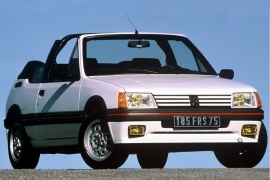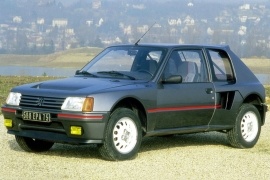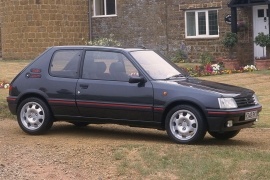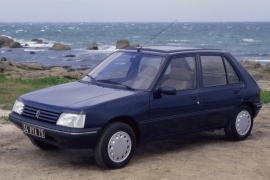PEUGEOT 205 Models/Series Timeline, Specifications & Photos
First production year: 1983
Engines: Gasoline, Diesel
Body style: Hatchback
After the success recorded with the pocket-rocket 205 GTI, the French carmaker Peugeot decided to offer it in an open-top version: the CTI.
Apart from the Golf GTI, there were hardly any other hot-hatches on the European market in the mid-'80s. Moreover, Volkswagen didn't offer an open-top version for it. In fact, there was no Golf II cabriolet at all. Peugeot took its chance and offered the GTI with a rag-top.
Peugeot didn't want to make the conversion all by itself and called Pininfarina studios for support. The Italian company made the design and produced most of the bodywork panels, which were exported to France, where the French carmaker finished the vehicle. It featured enlarged wheel arches and a sportier front bumper, which continued with an apron. The carmaker had to ad a roll-bar instead of the B-pillar to meet the safety requirements on its sides. Pininfarina cut the roof and the C-pillar and beautifully installed the fabric roof, so when the top was up, it looked like a regular, three-door 205.
The interior featured similar trims and materials as the GTI, but the sport bucket seats with high bolstering were fitted as standard. Since the roof had to fold behind the cabin, the rear bench was pushed forward, so there was hardly any room left for anyone in the back.
Under the hood, Peugeot installed the same 1.9-liter engine from the GTI, which provided 115 hp. A lower-budget version for the CTI was the CJI, which featured a 1.4-liter engine.
After closing the Peugeot 104 model, the French car-maker Peugeot came with a new supermini vehicle to fill the gap. It was named 205 and it was one of the greatest Peugeot cars ever made.
In the beginning, the 205 was not such a big success on the market. It wasn't until the 205 Gti stormed the World Rally Championship and grabbed victories and then the sales for the 205 exploded. The 205 was built in two main versions: 3 and 5 doors. There was also a convertible on the list, but that was not a mass-produced vehicle.
The 205 in 3-doors version was an affordable vehicle. It was fitted with low-powered engines that were also very fuel-efficient for those times. Its look was simple, with black plastic bumpers and square headlights. The grille was made out of three horizontal bars and the lion badge in the center. From the side, the long doors allowed easier access to the rear seats. The rear windows featured an optional front hinge that allowed them to slightly open outwards.
Inside, there was a flat dashboard with a glove compartment on the passenger side and a simple instrument cluster. No radio was offered as a standard option. The only standard device was the heating and ventilation system. No air-conditioning. The rear seats could fold to increase the otherwise very small trunk.
For the engine compartment, the car-maker installed a choice of gasoline and a 1.8 naturally aspirated diesel engine that was fuel-efficient and slow. The only transmission available was a 4-speed manual for most of the range. The top version, named 205 GTI was a completely different story.
Peugeot had to make 200 vehicles in a similar racing configuration to receive the FIA homologation number for the 205 T16 race-car, and it built them.
It was born in the golden era of the Group B rallying, and it had to exist in street clothing. The French carmaker tried its best to make it look like a civilized road car, but it couldn't. In the end, it looked like Hulk dressed in Batman's cape. Apart from one, which was white, all other 199 vehicles sported a dark charcoal gray color.
Forget everything about Peugeot 205 and Peugeot, generally speaking. The 205T16 was a different kind of animal. It built it to spit fire from its exhausts, to fly above Finland's gravel stages, and beat the Audi Quattro at its own game. The T16 was introduced too late to win the 1984 World Rally Championship but won three races. After that, it was a monstrous opponent that Audi couldn't catch. It forced the German carmaker to return to their drawing boards to develop a new racing car, but it was too late. Peugeot stormed the Rallye-stages and won the 1985 and the 1986 Championships. But FIA banned the Group B class afterward since it was too dangerous.
A team of twenty engineers led by Jean Todt developed the car. The idea was to build a similar-shaped existing car around a racing-special platform. In the end, they made 205 T16 with a tubular space-frame system with a transverse engine placed in the middle. Its all-wheel-drive system consisted of a center viscous center differential, with limited-slip differentials both front and rear. As for the bodywork, the team attached it around the roll-cage. Inside, Peugeot installed two sport bucket seats a large ashtray and a slide-in radio.
Jean Todt and his team did the math and planned the engine's displacement under the 2.5-liter equivalent rule, and the result was a 1,775 cubic centimeters (108.3 cu-in) turbocharged unit with a fuel-injected system. It provided 200 hp in the street version, while the racing model unleashed over 500 horses.
The 205 GTI is one of the greatest cars ever built by the French car-maker Peugeot. It was successful on the track and on the market. It was such an important car, that it becomes a collectible.
The 205 GTI was introduced to the market as a top version for the supermini Peugeot 205. It was a light car, with a very balanced chassis that could be driven hard on any road surface. It was approved for competition in Group N (minimal modifications) and Group A categories to compete in the 2WD class.
From the outside, the 205 GTI looked simple, with an angled rear-end. An evolution over the 104 model. But there was something that made the car unique: its headlights and the rear windows. The 205 GTI was available in 3 doors only. The C-pillar formed a specific shape that could have been recognized by any car enthusiast or any rally-fan. A specific set of alloy wheels were designed for the 205 GTI.
Inside, the instrument cluster, the gear-lever, and the pedals were as important to the driver as the high bolstered seats that could keep him in place while hard cornering. Thanks to its balance, the car could be understeered, neutral, or oversteered depending on the driver. It was the car that could make anyone understand what “lift-oversteer” means. One tap on the accelerator would instantly balance the car.
There were two GTI models: the 1.6- and 1.9-liter engines. The latter was the same as the former, but with a longer stroke. It featured a better torque, but not as rev-happy as the smaller version. There was only 5 hp difference between them and the most important difference was the rear disc-brakes for the version with the bigger engine.
Peugeot had to retire the aging 104 model and replace it with a new supermini range, named 205, which became the most successful model in the carmaker's stable and was offered as a hatchback with three or five doors and as a convertible.
Based on the same platform as the 1977 Peugeot 305, the 205 supermini was one of the most important cars in its class. It was built as an affordable vehicle, excellent inside crowded cities, and with fuel-efficient engines.
The car's design was signed by Gerard Walter, who created the new design language for the French carmaker. His ideas led to the brand's expansion on the market. The 205 featured a minimalist front fascia with rectangular headlights and corner-mounted blinkers. A plastic bumper covered the lower side of the front fascia. It was black for the lower trim levels and body-colored for the upper ones. At the back, the raked-forward tailgate offered a wide opening, flanked by small taillights.
Thanks to the transverse-mounted engine, the cabin offered enough room for front passengers. Moreover, due to the slim front bucket seats, there was enough legroom for the rear occupants as well. The flat dashboard provided a few storage compartments in front of the passenger. At the same time, the driver benefited from a unique-looking instrument cluster separated into two horizontal areas. On the upper one, the carmaker installed most warning lights, while on the lower side was the speedometer. Depending on the trim level and engine version, the 205 was also offered with a tachometer.
Peugeot offered the 205 with a wide choice of engines ranging from a 1-liter gasoline unit up to a 1.8-liter turbo-diesel. In addition, most versions were available with either four- or five-speed manual gearboxes, while a four-speed automatic was offered for selected engines.




